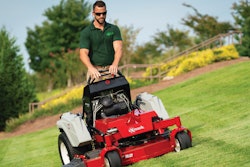
Creating a financial plan in times of uncertainty is no simple feat. When it feels like so much is out of your control it can be difficult to even grasp what makes good business sense.
Greg Herring, founder and CEO of The Herring Group, a consultant company, recently shared some business and financial advice with National Association of Landscape Professionals members on how to best respond to COVID-19. Herring says that how businesses respond early on could have a long-term impact.
Herring walked members through a five-step action plan which we’re recapping here.
Build Liquidity

Sources of liquidity include company cash, an already available line of credit, large deposits on construction projects or enhancement projects, and unpledged assets for collateral new loans, among other options. In addition, the U.S. Small Business Administration is offering designated states and territories low-interest federal disaster loans to businesses suffering substantial economic injury as a result of COVID-19 with an interest rate of 3.75 percent. Terms are determined on a case-by-case basis.
Understand the Customer Mindset
It is also wise to spend some time thinking about your customers’ mindset. How are they going to respond to COVID-19 and the resulting economic situation? The answer to that is largely dependent upon whom you serve.
For instance, residential construction or even maintenance customers might be more likely to halt services than HOAs. Think about your specific market segment and try to understand how they will react. If you’ve been through the Recession with them — as many landscape business owners have — you might already have some insight into their predicted response.
Plan for Various Scenarios
Now that you’ve thought through the potential response of your customers, try to formulate a plan based on these expectations. Consider various scenarios and how you might respond. For instance, if you put a division on hold, what does re-starting that division look like at a later date? What happens if your most profitable division starts to slow down? Do you have alternative revenue streams to which you can shift your focus? Try to plan out at least three to five different scenarios that could happen.
Calculate Cash Needs in Each Scenario

Consider Expense Reductions
Finally, you should also think about areas where you can cut costs and operate lean. The idea is to stay financially healthy until you can resume normal operations. For a lot of businesses, that could mean some tough decisions. For now, many remain positive that they’ll weather the storm just as they did during the Recession in 2008.
Pushing Ahead
Currently, at press time, a lot of states were in “lockdown” with only essential businesses remaining in operation. But Herring says it’s important for landscape business owners to interpret the “stay at home” language broadly.
“I am already seeing many lawn and landscape business owners interpreting those orders too narrowly and shutting down operations at a time when they don’t need to be shut down,” Herring says. “If your state or county’s ‘stay at home’ mandate considers construction as an essential business, then you should consider landscape as part of that language. As Americans, we are rule followers, and that can be a great thing. But we also need to keep our businesses afloat and there are ways to do it safely. You can close the offices but still have crews working in the field — keeping a safe distance and washing hands regularly. There are ways to push business forward.”


![Doosan Bobcat Wacker Neuson Stack 2ec Js Pb V6e[1]](https://img.greenindustrypros.com/mindful/acbm/workspaces/default/uploads/2025/12/doosan-bobcat-wacker-neuson-stack2ecjspbv6e1.CPyyz8ubHn.png?auto=format%2Ccompress&bg=fff&fill-color=fff&fit=fill&h=100&q=70&w=100)








![Doosan Bobcat Wacker Neuson Stack 2ec Js Pb V6e[1]](https://img.greenindustrypros.com/mindful/acbm/workspaces/default/uploads/2025/12/doosan-bobcat-wacker-neuson-stack2ecjspbv6e1.CPyyz8ubHn.png?ar=16%3A9&auto=format%2Ccompress&bg=fff&fill-color=fff&fit=fill&h=135&q=70&w=240)








